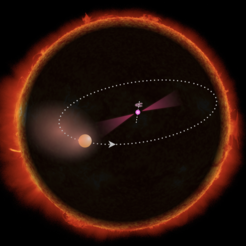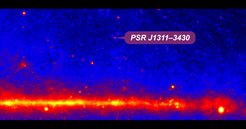A black widow's Tango Mortale in gamma-ray light
Max Planck scientists discover record-breaking millisecond pulsar with new analysis method.
Pulsars are the compact remnants from explosions of massive stars. Some of them spin around their own axis hundreds of times per second, emitting beams of radiation into space. Until now, they could only be found through their pulsed radio emissions. Now, scientists at the Max Planck Institute for Gravitational Physics (Albert Einstein Institute/AEI) in Hannover assisted by the Max Planck Institute for Radio Astronomy have discovered a millisecond pulsar solely via its pulsed gamma radiation. A new data analysis method developed by the AEI was crucial for the success. The pulsar is accompanied by an unusual sub-stellar partner, which it is vaporizing, hence the name “black widow”.

Back in 1994, astronomers discovered a source of strong gamma-rays in the constellation of Centaurus. They suspected that a pulsar was the origin of the energetic radiation. Now, a team of scientists led by Holger Pletsch from the Max Planck Institute for Gravitational Physics (Albert Einstein Institute, AEI) has solved the mystery and identified the culprit: the millisecond gamma-ray pulsar PSR J1311-3430. The developement of a new data analysis method by the AEI scientists enabled the discovery, since rapidly spinning pulsars are extremely difficult to find.
New method is the key
To unambiguously identify a gamma-ray pulsar, astronomers must know its properties to very high precision. This includes its position, spin frequency, and how the latter changes over time. If the pulsar is in a binary system, the analysis problem is even more complicated: at least three additional orbital parameters have to be determined as well.
In the case of PSR J1311-3430 astronomers had already observed the companion, which is heated by the radiation from the pulsar, with optical telescopes. They were thus able to partially constrain the orbital parameters and confine the position of the pulsar.
“We developed a particularly efficient method to search the data from NASA’s Fermi satellite for gamma-ray millisecond pulsars, including those in binary systems. Only this method enabled us to probe the wide parameter ranges,” says Holger Pletsch, lead author of the article published in Science. The new analysis method enables scientists to conduct a 'blind search' for gamma-ray millisecond pulsars for the first time – right up to very high spinning frequencies.
The scientists analysed the Fermi data on the Atlas computer cluster at the AEI. “Our search used data collected by the gamma-ray satellite over a total of four years. Very soon after we started running the analysis, a clear signal showed up in the results. What we saw was very exciting,” says Pletsch.
PSR J1311-3430 spins 390 times per second, emitting gamma-ray photons into space in the form of a beam, similar to a lighthouse. In roughly one in a million revolutions of the pulsar, a single photon reaches the detector on board Fermi.

The gamma-ray signal also reveals much about the companion to the astronomers: the orbital motion of the binary system modulates the photon arrival times, yielding information about the partner star. “The companion object is small and unusually dense,” says AEI Director Bruce Allen. “It is at least eight times as massive as the planet Jupiter, but has at most 60 percent the planet's radius.”
Black widow among pulsars
From this information, the researchers calculated the density of the companion, which turned out to be unusually high; it is around 30 times as dense as the Sun. Presumably, the small companion is the compact remnant of a star which has been orbiting the pulsar since earlier times. Over time, the pulsar accreted matter from the star, thereby accelerating its rotation. Pulsar and companion moved closer and closer together.
“At present, the remaining stellar core, which presumably consists mainly of helium, is heated by the radiation from the pulsar and literally evaporated,” says Holger Pletsch. Astronomers call this type of pulsar a 'black widow', in analogy with a species of spider which kills the smaller male after mating. In the distant future, PSR J1311-4330 might possibly completely vaporize its companion and from then on travel through space alone.
And that’s not all: “Our discovery is not only a first, it also sets several new records,” explains Bruce Allen. Currently, the odd couple is orbiting its common centre of mass on an almost perfect circular trajectory in only 93 minutes. This is the shortest known orbital period of all pulsars in binary systems.

At a distance of only 1.4 Earth-Moon separations, the binary system is the closest one known to date with a pulsar. The pulsar is speeding along its circular orbit with at least 13,000 kilometres per hour. Its light-weight companion is even faster, at up to 2.8 million kilometres per hour.
Holger Pletsch and his colleagues also had a close look at older observations with the Green Bank radio telescope in West Virginia, but were unable to find the fast pulsar here. “Apparently, the cloud of vaporized material from the companion absorbs most of the radio wave emissions from the pulsar and possibly makes it invisible to radio telescopes,” says Lucas Guillemot from the Max Planck Institute for Radio Astronomy in Bonn, co-author of the publication. The scientists are already planning further observations at higher radio frequencies. They hope to use them to accurately determine the object’s distance from Earth, for example.
The tip of the iceberg?
Systems like this provide astronomers with new insights into the evolution of very close binary systems, which are as yet still incompletely understood. PSR J1311-3430 could also shed new light on the generation of the gamma-ray photons and radio emissions in the strong magnetic field of pulsars. The pulsar may just be the tip of the iceberg: many other unidentified gamma-ray sources may harbour similarly unusual systems. Thirty years after the discovery of the first millisecond pulsar in the radio range, the novel analysis method of the Max Planck researchers at the AEI has opened a new door to the easier identification of these elusive celestial objects.
Background
The record-breaking pulsar system in numbers
Pulsar J1311-3430...
- spins 390.57 times around its axis every single second,
- has a surface magnetic field strength of 230 million gauss, about 500 million times that of the Earth (about 0.5 gauss),
- is the first millisecond pulsar discovered solely through its pulsed gamma radiation,
- orbits the centre of mass on an almost perfectly circular orbit in only 93 minutes, the shortest orbital period known among pulsars in binary systems,
- has an orbital speed of around 13,000 kilometres per hour.
Its companion...
- has a diameter of less than 88,000 kilometres, which is about 60 percent of the size of the planet Jupiter,
- is at least eight times as massive as the planet Jupiter,
- is on average 45 times denser than water, or 30 times as dense as our Sun,
- speeds along its almost perfectly circular orbit at a speed of up to 2.8 million kilometres per hour,
- is separated from the pulsar by a mere 520,000 kilometres, about 1.4 times the Earth-Moon separation,
- is so close to the pulsar that it is heated up by the strong radiation from the pulsar and slowly vaporizes.
The new search method / blind search
To unambiguously identify a gamma-ray pulsar, its properties must be known to a very high degree of precision. Only then can astronomers determine the rotational phase at which each of the gamma-ray photons was emitted by the pulsar. And only then can the gamma-ray pulsations be detected without doubt. None of the relevant pulsar properties, such as its position in the sky, its rotational frequency and how this changes, nor the orbital parameters of the binary system, are known a priori.
Researchers must check many combinations of these properties in a blind search. If the scientists were to immediately search through four years of Fermi data, the number of possible combinations would be so large that the computing effort required would make a practical implementation impossible.
The new analysis method splits the full data set into shorter overlapping sections. Each of the sections can now be searched separately; the individual results are then combined in an optimal way. Overall, this search method is almost as sensitive as a search through the full four-year data set in one run. If a promising signal is found at a particular parameter combination, the full set of data can be checked with this combination very quickly.
The key is to distribute the parameter combinations as cleverly as possible so that any signal is found with the highest possible probability and unnecessary computations are avoided. The new analysis method employs an algorithm which adaptively improves the parameter combinations – also called grid points – to cover the total parameter space while keeping computing costs as low as possible. “Initially, our method distributes the grid points purely randomly. After that, the algorithm checks whether the points are too close to each other and shifts them if required,” says Henning Fehrmann from the AEI.
Pulsars and the Fermi space observatory
Pulsars are compact neutron stars born in supernova explosions which rotate rapidly and steadily about their axis. Their intense magnetic field causes them to emit radio waves or gamma-ray photons in the form of a diverging beam. Their rotation sweeps the beam through space like the beam from a lighthouse. When the neutron star is pointing towards Earth, it is visible as a pulsar.
Not all pulsars show up in multiple spectral ranges simultaneously. In some cases, the scientists measure only the flashes as a radio pulsar; in other cases, only the periodic arrival times of gamma- ray photons can be registered. The most likely causes for the different pulsar types are the different orientations of the emission regions in the extremely strong magnetic field of the neutron star and its orientation towards Earth.
If the pulsar is in a binary system after its formation, it can accrete matter from its companion as the latter evolves. It transfers angular momentum to the pulsar and speeds up its spin. This process is called “recycling” of pulsars and explains the origin of millisecond pulsars, which spin several hundred times per second about their axis.
Until now, astronomers have found most pulsars in the radio wave range. However, thanks to NASA’s Fermi satellite, they are discovering more and more of these celestial bodies via their high- energy gamma radiation. Fermi has been observing the universe with its Large Area Telescope (LAT) in the gamma range since 2008. It has discovered hundreds of new sources, many of which are probably as yet undiscovered pulsars.














